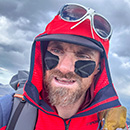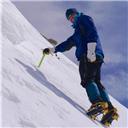some background before my questions
Here is what I have read so far:
Freedom of the Hills, snow climbing chapter, and others
Snow Travel: Techniques for climbing, hiking, and moving across snow
Staying alive in Avalanche Terrain, 2E (on page 161 right now as I type this)
Colorado snow climbs: A guide for all seasons
Gear I have:
Ice Ax, mountaineering boots, crampons, helmet, cold weather gear. (no rope or pro)
This coming Sunday (4/27) I am taking a class with Pikes Peak Alpine School on all the basics (movement, foot work, self arrest, etc)
Which brings me to the question, now what? I've read, bought the gear, and sought proper instruction but the thought of just walking up to couloir and having a go at it seems intimidating, and more than likely stupid.
Do most people just go on a guided climb after that, and then find a climbing partner here on the forums? Do I join some club?
What do most climbers do to assess the stability of the slopes in the couloir? Sure you can walk up and find a sheltered area on the approach to dig a snow pit and do some analysis, but if your sample is taken at a 25 degree angle how will that help you when the crux is 2000 ft higher and around 40 degrees and in the shade or vice versa? Aside from hearing some whumping or shooting cracks on the approach it seems as if there is not much of way to know these things definitively. Is this simply just part of the objective hazard you must accept when attempting to climb couloirs?
Couloir climbing questions
Forum rules
- This is a mountaineering forum, so please keep your posts on-topic. Posts do not all have to be related to the 14ers but should at least be mountaineering-related.
- Personal attacks and confrontational behavior will result in removal from the forum at the discretion of the administrators.
- Do not use this forum to advertise, sell photos or other products or promote a commercial website.
- Posts will be removed at the discretion of the site administrator or moderator(s), including: Troll posts, posts pushing political views or religious beliefs, and posts with the purpose of instigating conflict within the forum.
-
Mike Shepherd

- Posts: 260
- Joined: 4/21/2014
- 14ers: 12
- 13ers: 5
- Trip Reports (3)
Couloir climbing questions
Friends don't let friends wear microspikes
-
d_baker
- Posts: 3179
- Joined: 11/18/2007
- 14ers: 58 15
- 13ers: 369 11
- Trip Reports (59)
Re: Couloir climbing questions
My suggestion is to first experience your class with Pikes Peak Alpine School, ask them questions throughout your day, and then take some time to reflect.
If you enjoyed your day out, then try to connect with partners on here or you could join the CMC (Colorado Mtn Club). There's a Pikes Peak Group, and they have a BMS (Basic Mountaineering School) that also utilizes the Glenn Cove area on Pikes Peak, which is where I assume you'll be going w/Pete this weekend.
Enjoy yourself, and welcome to the sport of climbing snow!
If you enjoyed your day out, then try to connect with partners on here or you could join the CMC (Colorado Mtn Club). There's a Pikes Peak Group, and they have a BMS (Basic Mountaineering School) that also utilizes the Glenn Cove area on Pikes Peak, which is where I assume you'll be going w/Pete this weekend.
Enjoy yourself, and welcome to the sport of climbing snow!
-
Hoot

- Posts: 166
- Joined: 7/13/2007
- 14ers: 58
- 13ers: 150
- Trip Reports (36)
Re: Couloir climbing questions
I took the Pikes Peak Alpine class 9 years ago with Bruce Hamilton and we practiced our skills on Little Italy (which was in great shape this past Saturday). Assuming you're comfortable with self-arrest, I recommend making plans with one or two of your classmates to return to climb Little Italy sometime after the class. Or as Darin suggests, join the CMC to learn new skills and meet lots of climbing partners.
-
Double Oh Seven

- Posts: 101
- Joined: 8/10/2012
- 14ers: 19
- 13ers: 23 1
- Trip Reports (5)
Re: Couloir climbing questions
Hi Mike,
I was in a similar situation as you when I started snowclimbing a few years ago. I started with some easy to moderate climbs (angel of shavano, castle peak, queensway, mt. jasper. In terms of avalanche risk we are getting to the time of year where i focus more on getting out real early and off the snow within an hour or so after sunhit and making sure we had a hard freeze and a clear sky the night before then actually digging pits. As the snowpack consolidates the risks of slab avalnches that a pit would discover have started to reduce and the bigger concern becomes wet slides. There are some caveats to this as northern aspects will take longer to consolidate for example
To be honest i have taken avy1 but still dont feel comfortable making a go or no go decision based on a pit I dig.
If you like the class and are looking for someone to climb with I would certainly be up for it over the next few months. I have not taken a snowskills class and while not a substitue I have done a decent of self arrest and skills practice on my own.
I was in a similar situation as you when I started snowclimbing a few years ago. I started with some easy to moderate climbs (angel of shavano, castle peak, queensway, mt. jasper. In terms of avalanche risk we are getting to the time of year where i focus more on getting out real early and off the snow within an hour or so after sunhit and making sure we had a hard freeze and a clear sky the night before then actually digging pits. As the snowpack consolidates the risks of slab avalnches that a pit would discover have started to reduce and the bigger concern becomes wet slides. There are some caveats to this as northern aspects will take longer to consolidate for example
To be honest i have taken avy1 but still dont feel comfortable making a go or no go decision based on a pit I dig.
If you like the class and are looking for someone to climb with I would certainly be up for it over the next few months. I have not taken a snowskills class and while not a substitue I have done a decent of self arrest and skills practice on my own.
-
justiner

- Posts: 4690
- Joined: 8/28/2010
- 14ers: 3 1
- Trip Reports (37)
Re: Couloir climbing questions
i go when conditions are stabilized, as early as i can, and as fast as i can go. haven't started at all this year.
Long May You Range! Purveyors of fine bespoke adventures
-
colokeith

- Posts: 435
- Joined: 1/3/2011
- 14ers: 39 2
- 13ers: 34 3
- Trip Reports (7)
Re: Couloir climbing questions
I go with the same approach as mentioned above.
For a few days prior to the climb I watch for any new snow, and monitor temperatures to make sure there is a good freeze thaw cycle going on. Start early and be off the route before the sun has a chance to warm things up. A late start increases both the chance of a wet snow avalanche, and rock fall hazard. To early of a start and the route may be a little too firm (especially for skiing) and you will be cold. So there is a bit of a fine line.
If you go for some of the easier routes 30-40 degree I bet you will be surprised at how mellow it is when you are on it. Just make sure you have your self arrest technique down pat, and then don't fall :D
For a few days prior to the climb I watch for any new snow, and monitor temperatures to make sure there is a good freeze thaw cycle going on. Start early and be off the route before the sun has a chance to warm things up. A late start increases both the chance of a wet snow avalanche, and rock fall hazard. To early of a start and the route may be a little too firm (especially for skiing) and you will be cold. So there is a bit of a fine line.
If you go for some of the easier routes 30-40 degree I bet you will be surprised at how mellow it is when you are on it. Just make sure you have your self arrest technique down pat, and then don't fall :D
To climb is to push yourself in a way you might not normally imagine is possible. If your stamina, skill, and luck are sound you will get to stand on top. ... I realized that with climbing, I'd found something that nourished my soul and could forge me into a better version myself - Jim Davidson
-
Mike Shepherd

- Posts: 260
- Joined: 4/21/2014
- 14ers: 12
- 13ers: 5
- Trip Reports (3)
Re: Couloir climbing questions
Luckily or unfortunately I don't ski (yet at least)colokeith wrote:Too early of a start and the route may be a little too firm (especially for skiing) and you will be cold. So there is a bit of a fine line.
If you go for some of the easier routes 30-40 degree I bet you will be surprised at how mellow it is when you are on it. Just make sure you have your self arrest technique down pat, and then don't fall :D
I hope that is indeed the case about being mellow the pictures essentially make 40 degrees look incredibly steep.
It would seem to me the easiest way to ensure an early start would be to camp out the night before as close as possible to the approach, is this what most of you do or not?
Friends don't let friends wear microspikes
-
Scott P

- Posts: 9598
- Joined: 5/4/2005
- 14ers: 58 16
- 13ers: 50 13
- Trip Reports (16)
Re: Couloir climbing questions
Snow pits provide very useful information for a winter snowpack, but usually not so much for a late spring/early summer snowpack.Sure you can walk up and find a sheltered area on the approach to dig a snow pit and do some analysis
In Colorado, winter and early spring avalanches usually have different causes from those in late spring early summer. Late spring/early summer avalanches are caused by a saturated snowpack that has been melting and on a warm day flows downhill like a Slurpee.
Snow pits don't do you much good in this regard. The best plan of attack is to start early (as in very early or the middle of the night) and be out of the couloir before afternoon heating takes place. The colder the night, the better.
40 degree snow is actually steep. Most people overestimate angles. By way of comparison, 35 degrees is usually the cut off for "Expert" runs at the ski resorts. Very few ski resort's expert ski runs exceed 35 degrees. Jackson Hole and Squaw Valley are the only ski areas in the nation that have an official run that exceeds 40 degrees over a minimum 500 feet length. Of course backcountry couloir climbs and ski descents can easily exceed this.I hope that is indeed the case about being mellow the pictures essentially make 40 degrees look incredibly steep
Last edited by Scott P on Mon Apr 21, 2014 9:19 pm, edited 3 times in total.
I'm old, slow and fat. Unfortunately, those are my good qualities.
-
d_baker
- Posts: 3179
- Joined: 11/18/2007
- 14ers: 58 15
- 13ers: 369 11
- Trip Reports (59)
Re: Couloir climbing questions
I think 'steepness' is relative to snow conditions. The harder the snow, the steeper it feels. When you can get a good kick step going that creates a little platform as you go up, the angle generally doesn't feel as steep -- or at least that's been my experience.
I've camped out before snow climbs before, but it really depends on what I plan to climb. It's nice to get at a base of a couloir as the sun is cresting the horizon. Aspect will dictate start times too (i.e., if it's E/SE/S facing start earlier -- W/NW/N facing you can get away with later starts -- but it also depends on overnight lows/sky cover/temps expected the day of climb/etc.).
You'll probably hear or read about snow saturation with a spring time snowpack. If you can pick up a handful of snow and get water out of it, get off steep snow, and don't climb/hike underneath steep slopes. Roller pins are something else to watch for as they are a sign of the surface snow gaining in saturation.
I've camped out before snow climbs before, but it really depends on what I plan to climb. It's nice to get at a base of a couloir as the sun is cresting the horizon. Aspect will dictate start times too (i.e., if it's E/SE/S facing start earlier -- W/NW/N facing you can get away with later starts -- but it also depends on overnight lows/sky cover/temps expected the day of climb/etc.).
You'll probably hear or read about snow saturation with a spring time snowpack. If you can pick up a handful of snow and get water out of it, get off steep snow, and don't climb/hike underneath steep slopes. Roller pins are something else to watch for as they are a sign of the surface snow gaining in saturation.
-
Big Schwimm

- Posts: 36
- Joined: 7/9/2009
- 14ers: 58 6
- 13ers: 41
- Trip Reports (0)
Re: Couloir climbing questions
Join your local CMC group. Take some additional classes. Use their trip schedule to sign up for some snow climbs. Meet some people from the group. Use your new found skills to meet people on other forums.
The Mountains make us all feel small . . .
-
Dave B

- Posts: 2419
- Joined: 6/14/2010
- Trip Reports (9)
Re: Couloir climbing questions
I think the approach anyone takes in learning these skills is going to be entirely dependent on risk acceptance.
The first couloir climb I did on my own (Queensway on Apache Peak) I carried pickets and a rope and protected the entirety of the route. About halfway up I felt like a total fool for doing so - the couloir maxes out at maybe 35 degrees and is pretty tame. However, that was what I personally needed to get out there and "lead" a couloir.
The bottom line is to get experience. Take a CMC or CMS class, try to find more experienced partners on here or elsewhere. Get as much experience as you can because, as nice as it seems, strangers giving advice on the internet will never have the same staying power as learning on your own.
As far as assessing avalanche conditions, spring time is pretty stable in CO. From mid-May through the end of June (for the most part) you really just need to start early and get the hell off of or out from underneath steep slopes when you can sink into wet snow up to your ankles - in other words you probably want to be on your way back down well before noon regardless of slope angle or aspect. Anytime before mid-May, you need to have a solid grasp of assessing avalanche conditions. That comes with experience, reading and education.
Buena suerte!
The first couloir climb I did on my own (Queensway on Apache Peak) I carried pickets and a rope and protected the entirety of the route. About halfway up I felt like a total fool for doing so - the couloir maxes out at maybe 35 degrees and is pretty tame. However, that was what I personally needed to get out there and "lead" a couloir.
The bottom line is to get experience. Take a CMC or CMS class, try to find more experienced partners on here or elsewhere. Get as much experience as you can because, as nice as it seems, strangers giving advice on the internet will never have the same staying power as learning on your own.
As far as assessing avalanche conditions, spring time is pretty stable in CO. From mid-May through the end of June (for the most part) you really just need to start early and get the hell off of or out from underneath steep slopes when you can sink into wet snow up to your ankles - in other words you probably want to be on your way back down well before noon regardless of slope angle or aspect. Anytime before mid-May, you need to have a solid grasp of assessing avalanche conditions. That comes with experience, reading and education.
Buena suerte!
Make wilderness less accessible.
Re: Couloir climbing questions
Now that is a good question to ask. Make friends at your class this weekend. Classes like that are a good place to meet people with similar interests and abilities to yourself. Also ask around on this site and any where else too. Try to start building a group of people you will climb with for a while. This takes time and can be frustrating starting out but it will work out. I have friends I have been climbing with for over ten years now. Building those relationships does take time. Yeah, when you are ready go walk up a couloir, go walk up a couloir. Plan it, do research, find a partner or two you trust, and go for it.This coming Sunday (4/27) I am taking a class with Pikes Peak Alpine School on all the basics (movement, foot work, self arrest, etc)
Which brings me to the question, now what? I've read, bought the gear, and sought proper instruction but the thought of just walking up to couloir and having a go at it seems intimidating, and more than likely stupid.
Do most people just go on a guided climb after that, and then find a climbing partner here on the forums? Do I join some club?
What do most climbers do to assess the stability of the slopes in the couloir? Sure you can walk up and find a sheltered area on the approach to dig a snow pit and do some analysis, but if your sample is taken at a 25 degree angle how will that help you when the crux is 2000 ft higher and around 40 degrees and in the shade or vice versa? Aside from hearing some whumping or shooting cracks on the approach it seems as if there is not much of way to know these things definitively. Is this simply just part of the objective hazard you must accept when attempting to climb couloirs?
This is a really challenging thing with your life hanging it the balance. It takes years to really become proficient at this but this is how I go about it:
1)Read the Colorado Avalanche Information Center report
2)Talk to friends that have been in the area recently
3)Look at recent condition/trip reports (this site is a great resource)
4)Take a detailed look at the weather forecast for your planned climb. What type of issues might you have that day? Is there new snow in the forecast? What direction and how hard are winds blowing? What are the over night highs and low? Especially is it freezing overnight and are temps getting above freezing during the day? What is the forecasted cloud cover for the day? How are all these weather factors going to contribute to snow/avalanche conditions on your climb?
5)On your climb look for signs of recent avalanche activity. Look/listen for instabilities (crack, collapsing, whumping, rollerballs etc...)
6)Pay close attention for changes in snow conditions. Are you transitioning onto a slab? Are your feet punching in deeper than they were a few minutes prior?
7)Use snow pits but be very wary of what they say. Spacial variability is very dramatic in our snowpack.
Most importantly remember you are using inductive reasoning to evaluate snow conditions constantly so keep in mind that no single piece of evidence is going to tell you to go or not go. You are responsible for gathering information before you climb, gathering information while you climb, and for constantly reevaluating conditions as you climb. Never be afraid to turn around!
Have fun, be safe, and welcome to the snow climbing community!
"May your trails be crooked, winding, lonesome, dangerous, leading to the most amazing view. May your mountains rise into and above the clouds." Edward Abbey
...
http://www.zachtaylorsnowboarding.com" onclick="window.open(this.href);return false;
http://www.14ersnowboardproject.homestead.com" onclick="window.open(this.href);return false;
...
http://www.zachtaylorsnowboarding.com" onclick="window.open(this.href);return false;
http://www.14ersnowboardproject.homestead.com" onclick="window.open(this.href);return false;


